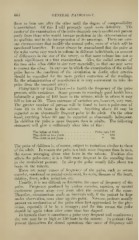Page 654 - My FlipBook
P. 654
664 GENERAL PATHOLOGY. ;
them to bear one after the other until the degree of compressibility
is ascertained. Of this I will presently speak more definitely. The
matter of the examination of the pulse demands much careful and patient
study from those ^Yho would become proficient in the determination of
its qualities and in the interpretation of its meanings. There are vari-
ous circumstances that modify the normal pulse, some of which will be
mentioned hereafter. It must always be remembered that the pulse at
the wrist varies very much in volume in different individuals, on account
of differences in the size of the artery, so that mere volume has not so
much significance at a first examination. Also, the radial arteries of
the two sides often differ in size very materially, so that one may serve
to correct the other. In any case in which the examination of the radial
])ulse leaves the condition of the circulation in doubt, other arteries
should be consulted for the more perfect correction of the readings.
In the administration of anaesthetics it is very convenient to take the
pulse from the temporal artery.
Frequency of the Pul8I-:.—In health the frequency of the pulse
presents wide variations. Some persons in seemingly good health have
habitually a pulse of 100 beats in the minute, while in others it may
fall as low as 50. These extremes of variation are, however, very rare.
The greater number of persons will be found to have a pulse-rate of
from 60 to 85 beats in the minute. Anything above 85 may be
regarded as an abnormally frequent pulse in the adult. On the other
hand, anvthing below 60 may be regarded as abnormally infrequent.
In children the pulse is more frequent than in adults. The following
statement will give a suflficientlv clear idea of this :
The infant at birth Pulse-rate 140
The child at five years " J 00
"
The child at tert years 90
The pulse of children is, of course, subject to variations similar to those
of the adult. In women the pulse is a little more frequent than in men,
the excess averaging about nine beats in the minute. Position also
affects the pulse-rate ; it is a little more frequent in the standing than
in the recumbent posture. In sleep the pulse usually falls about ten
beats in the minute.
There are many causes of frequency of the puke, such as severe
exercise, emotional or mental excitement, hysteria, diseases of the heart,
debility, fever, reflex irritation, etc.
Usually, it is not difficult to determine the cause of frequency of the
pulse. Frequency produced by violent exercise, emotion, or mental
excitement passes away very soon after the cessation of the cause.
Therefore, examinations made at intervals will, if the patient be kept
under observation, soon clear up this point. Nervous patients usually
present an acceleration of the pulse when first approached by the phy-
sician, especially if he be a stranger ; and for this reason the pulse
should be again taken after some time has elapsed.
In hysteria there is sometimes a pulse very frequent and continuous
the rate may be as high as 150 beats in the minute. In patients that
present themselves for dental operations this cause of frequency will


